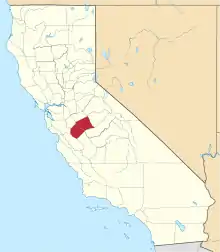Yamato Colony, California
Yamato Colony, California was a Japanese agricultural community in Livingston, California, United States. The Japanese farmers were instrumental in founding the Livingston Farmers Association.
The Yamato Colony was established by Kyutaro Abiko, who purchased 3,200 acres (13 km2) in Livingston through his American Land and Produce Company, and then encouraged Japanese farmers to settle there. Abiko intended the colony to be a "Japanese Christian utopian colony". The Japanese settlers made an effort to fit in with the existing community by confining their economic activities to farming and patronizing European-American merchants. After struggling with wind and water problems, and the failure of Abiko's bank, the colony began to prosper with the formation of the Livingston Cooperative Society in 1914. In 1927, this cooperative split into the Livingston Fruit Growers Association and the Livingston Fruit Exchange. The two cooperatives were re-united in 1956.[1]
At the beginning of World War II, in anticipation of internment, the residents of Yamato and two other colonies established by Abiko, Cressey, and Cortez, formed a corporation headed by a European-American to hold their property. As a result, the Japanese residents of Yamato were able to reclaim their property after the war. As late as 1980, close to one-third of the members of the Livingston Cooperative were still Japanese.[1]
Most of the original area of the colony is now part of the city of Livingston. After tract homes were built in the original area of the colony, the Yamato Colony elementary school was built to serve the neighborhood.
See also
References
- Niiya, Brian (1993). "Yamato Colony (Calif.)". Japanese-American History: An A-to-Z Reference from 1868 to the Present. New York, New York: Facts on File. pp. 356–57. ISBN 0-8160-2680-7. Retrieved 3 January 2012.
yamato colony texas.
